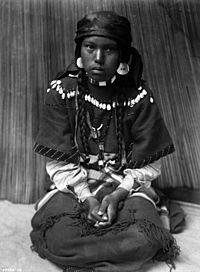Pend d'Oreilles facts for kids

Touch Her Dress, a Kalispel girl, ca. 1910
|
|
| Total population | |
|---|---|
| over 400 | |
| Regions with significant populations | |
| United States (Montana, Washington) |
|
| Languages | |
| Kalispel-Pend d’Oreille, English | |
| Religion | |
| traditional tribal religion | |
| Related ethnic groups | |
| Chewelah, Spokane |
The Pend d'Oreille people, also known as the Kalispel, are a Native American tribe from the Northwest Plateau region. Today, many of them live in Montana and eastern Washington. Their traditional homeland was known as Kaniksu.
Their traditional lands included the areas around the Flathead River, Clark Fork, and Pend Oreille rivers. This land stretched from Plains, Montana, west along the Clark Fork River, to Lake Pend Oreille and Priest Lake in Idaho. It also went along the Pend Oreille River (which they called Ntxwe, meaning "river") in eastern Washington and into British Columbia in Canada.
The Pend d'Oreille people lived in many groups, probably eleven originally. They are generally split into two main parts based on where they lived and their culture:
- The "upstream people" or Upper Kalispel (also called "Upper Pend d’Oreille") are known as the Pend d'Oreille. They were also called Kullyspelm or Ql̓ispé, meaning "Camas People". Today, they are part of the Confederated Salish and Kootenai Tribes of the Flathead Nation in Montana.
- The "downstream people" or Lower Kalispel (also called "Lower Pend d’Oreille") are known as the Kalispel. They were also called Silkatkmlschi or Sɫq̓etkʷmsčin̓t, meaning "People Living along the Shore of the Broad Water". This is because they lived by Flathead Lake (which they called Čɫq̓étkʷ, meaning "Broad Water"). Today, they are part of the Kalispel Tribe of Indians in Washington. Some families are also part of the Coeur d’Alene Tribe in Idaho.
Some Kalispel people are also part of the Confederated Tribes of the Colville Reservation in eastern Washington. Before European-Americans settled the area, the town of Chewelah was home to a group of Lower Kalispel people. This group was called the Slet̓éw̓si, meaning "valley people". The Chewelah Band of Indians is now part of the Spokane Tribe of Indians in Washington.
Contents
Understanding Their Names
The name Pend d’Oreille was given to them by French explorers and traders. It means "hangs from ear" and refers to the large shell earrings these people wore.
The name Kalispel comes from their own language, Ql̓ispé. This name means "Camas people". Camas is a flower bulb that was a very important food for them.
Their Language
The language spoken by the Pend d'Oreille and Kalispel people is called Kalispel-Pend d’Oreille. It is a Southern Interior Salish language. It is also known as Flathead-Kalispel.
Where They Live Now: Reservations
The Pend d'Oreille people have two main reservations. One is the Flathead Indian Reservation in western Montana. The other is the Kalispel Indian Reservation in Washington. A small number of Kalispel people also live on the Colville Indian Reservation in Washington.
The main part of the Kalispel Reservation is in central Pend Oreille County, northwest of Newport, Washington. This main reservation is a strip of land about 18.6 square kilometers (7.2 square miles) along the Pend Oreille River. It is west of the Washington–Idaho border.
There is also a smaller piece of land in Airway Heights, near Spokane. This area is about 0.2 square kilometers (50 acres). It is where the tribe runs the Northern Quest Casino. The total land area of the Kalispel Indian Reservation is about 18.8 square kilometers (7.3 square miles). The closest town is Cusick, which is near the south end of the reservation.
A Look at Their History

It is believed that the Pend d'Oreille people moved south from British Columbia. In 1809, a fur trading company called the North West Company built a trading post in their territory. They named it Kullyspell House. Later, in 1846, Catholic missionaries started a Roman Catholic mission there.
In 1855, the tribe divided into two groups: the upper and lower divisions. The upper group moved to the Flathead Reservation in Montana. One of the two lower groups joined them in 1887.
These people made their weapons and tools from flint and shaped many other things with rocks. For homes, the Pend d’Oreille lived in tipis during the summer. In winter, they lived in lodges. These houses were built using large cattails, which grew in large amounts where the people lived. They wove these cattails into mats called “tule mats”. These mats were then attached to a tree branch frame to create a hut. Today, a large community building on the Kalispel reservation is named “Tule Hut” to honor this traditional way of building homes.
The tribe traded bison hides for horses and other useful goods. They traditionally made clothes from rabbit furs and deer hides. They decorated these hides with dyes, paints, beads, and porcupine quills.
The Upper Pend d’Oreille on the Flathead Reservation had a disagreement with the state of Montana about hunting outside the reservation. This led to a sad event known as the Swan Valley Massacre of 1908.
For many years after they lost their original lands around Lake Pend Oreille, the Pend d'Oreille group of Kalispel people continued to hold an annual pow wow. This gathering took place on their traditional grounds just east of what is now Sandpoint City Beach. The three-day event included ceremonies, dancing, and traditional stick games. The pow wows in Sandpoint stopped in the early 1950s.
Since 1975, the Kalispel Tribe has held an annual pow wow at their Usk, Washington, reservation in July or August. These events are open to everyone. They include a dance contest, traditional foods, stick games, and other activities.
See also
 In Spanish: Pend Oreille para niños
In Spanish: Pend Oreille para niños

